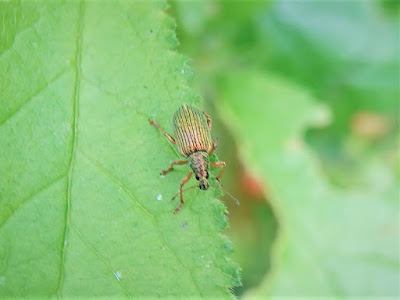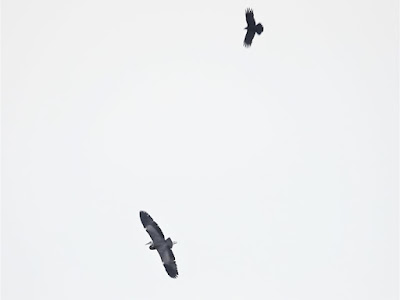9.0°C > 12.0°C: Back to low cloud with few signs it might break imminently. Light east-north-east wind. Good visibility and rather hazy.
Sunrise: 04:50 BST again
* = a photo of this species today
Priorslee Balancing Lake: 05:10 – 06:10 // 07:05 – 09:25
(119th visit of the year)
Undoubted highlight today was a Weasel that ran across the concrete ramp carrying prey c.07:20. As far as I can remember this is my first sighting here. There are no records in my dated logs back to 2014.
Bird notes:
- I remain unable to confirm that one pair of Great Crested Grebes has young.
- A Willow Warbler was giving an occasional partial song this morning.
- I did not hear or see the Sedge Warbler. I am glad I managed a photo of it yesterday.
- Two of the Reed Warblers were singing from outside the reed beds.
Birds noted flying over here:
- 2 Canada Geese: outbound together
- 6 Greylag Geese: a quartet and a duo inbound
- 8 Feral Pigeons: together
- 5 Wood Pigeons
- 4 Lesser Black-backed Gulls
- 3 Cormorants: single and duo
- 3 Jackdaws
Warblers noted (the number singing in brackets):
- 1 (1) Cetti's Warbler
- 1 (1) Willow Warbler
- *11 (8) Chiffchaffs
- no Sedge Warbler
- 8 (8) Reed Warblers
- 15 (12) Blackcaps
- 1 (1) Garden Warbler
- *2 (1) Common Whitethroats
Hirundines etc., noted:
- >30 Swifts
- 2 Barn Swallows
- 2 House Martins
Counts from the lake area: it remains very quiet
- 10 Canada Geese: arrived together
- 2 + 2 (1 brood) Mute Swans
- 2 (2♂) Mallard: also a pair on a roof in Teece Drive c.06:10 only
- 2 (1♂) Tufted Duck
- 2 Moorhens
- 26 + 21 (9 broods) Coots
- 8+ ? (1 brood) Great Crested Grebes
- 1 Herring Gull: first summer
- 2 Lesser Black-backed Gulls: immatures
+ = my first sighting of this species this year.
++ = new species for me at this site.
Noted on and around the street lamp poles at dawn:
- stretch spider Tetragnatha sp.
Noted later: when the wind is in the east it blows on to the sunny areas keeping the insect numbers low.
Butterflies:
- none
Moths:
- *Timothy Tortrix (Zelotherses paleana)
- Plum Tortrix (Hedya pruniana)
Bees / wasps etc.:
- Garden Bumblebee (Bombus hortorum)
- *Common Wasp (Paravespula vulgaris)
- Garden Bumblebee (Bombus hortorum)
- *Common Wasp (Paravespula vulgaris)
Dragon-/damsel-flies:
- none
- none
Hoverflies:
- none
Other flies:
- Black Snipefly (Chrysopilus cristatus)
- Grouse Wing caddis fly (Mystacides longicornis)
- *Tiger Cranefly (Nephrotoma flavescens)
- Yellow Dung Fly (Scathophaga stercoraria)
- *another cranefly sp.
- *two species of unidentified fly.
- none
Other flies:
- Black Snipefly (Chrysopilus cristatus)
- Grouse Wing caddis fly (Mystacides longicornis)
- *Tiger Cranefly (Nephrotoma flavescens)
- Yellow Dung Fly (Scathophaga stercoraria)
- *another cranefly sp.
- *two species of unidentified fly.
Beetles:
-. Raspberry Beetle (Byturus tomentosus)
- *Nettle Weevil (Phyllobius pomaceus)
-. Raspberry Beetle (Byturus tomentosus)
- *Nettle Weevil (Phyllobius pomaceus)
Bugs:
- *Common Green Capsid (Lygocoris pabulinus)
- *Common Green Capsid (Lygocoris pabulinus)
Also
- White-lipped Snail (Cepaea hortensis)
- stretch spider Tetragnatha sp.
- *another spider sp.
- *flower head of Elder (Sambucus nigra)
- White-lipped Snail (Cepaea hortensis)
- stretch spider Tetragnatha sp.
- *another spider sp.
- *flower head of Elder (Sambucus nigra)
The identification was resolved here with the upper-wing pattern visible as it flew to a buoy. The inner primaries which would normally be paler and be the easiest identification feature have been dropped as part of the moult. It is a Herring Gull because the secondary coverts are pale – they would be the same tone as the secondaries themselves on a Lesser Black-backed Gull. It needs to practice its balancing skills.
Probably one of the Chiffchaffs I photographed yesterday.
Probably not one of the Common Whitethroats I photographed yesterday as it was singing some way from where yesterday's birds were noted gathering food.
A much better angle on this Timothy Tortrix moth (Zelotherses paleana). The yellow wash on the shoulder is the main feature of this otherwise pale grey moth.
This is the German Wasp (Vespula germanica) I photographed yesterday showing the rather triangular shape to the yellow on the side of its thorax.
Compare this Common Wasp (Paravespula vulgaris) I saw in the same place today. The yellow on the side of the thorax has almost parallel sides.
This is the face pattern of that German Wasp.
And for comparison the face pattern of the Common Wasp. Apologies it is not quite in focus: partly due to there being less light today and partly due to this being a somewhat aggressive individual that kept chasing me.
An almost plan view of a Tiger Cranefly (Nephrotoma flavescens).
An almost side-elevation view of the same Tiger Cranefly.
"Oh er missus". A small cranefly seems to be walking over a fly!
Unidentified fly #1.
Unidentified fly #2. Not all hairy unlike many I have seen recently.
A Nettle Weevil (Phyllobius pomaceus). Well the back is in focus!
Not too much to show today so here is a reminder as to what a Common Green Capsid (Lygocoris pabulinus) looks like. It needs to work on finding the correct coloured leaf to camouflage it.
I found this small male spider on the wall of the sailing club HQ. I wondered whether the two pale marks at the front of the abdomen might provide a clue to its identity but nothing seems obvious from scanning the spider gallery in eakringbirds.com. As previously noted the abdomen pattern on many species is 'variable'.
A flower head of Elder (Sambucus nigra). Despite the abundant small flowers there was an article in an edition of British Wildlife magazine last year that noted that toxins in the flowers make in unattractive as a nectar source to most insects.
(Ed Wilson)
------------------------------------------------------------------------------------------------------
The Flash: 06:15 – 07:00
(110th visit of the year)
Bird notes:
- The Coots seem to be having a bad year. My visits at this time of year are early in the morning: the recent broods tend to be still hiding under adults in the nest. But I have seen very few 'advanced' and independent juveniles so far this year an some of those seem to have disappeared.
Birds noted flying over here:
- 2 Cormorants together
- *1 Grey Heron
Warblers noted (the number singing in brackets):
- 5 (5) Chiffchaffs
- 4 (4) Blackcaps
Hirundines etc., noted:
- 1 House Martin
Noted on / around the water
- 77 Canada Geese
- 5 Greylag Geese
- 3 + 4 Mute Swans:
- 25 (20♂) Mallard
- 1 (1♂) all-white duck (Peking(?) Duck)
- 12 (8♂) Tufted Duck
- 7 Moorhens
- 22+ 4 (2 broods) Coots: a new brood of three seen
- 4 Great Crested Grebes
Noted on / around the street lamp poles:
NB: Yesterday's possible Common Marbled Carpet moth has been identified by the Shropshire recorder as a May Highflyer (Hydriomena impluviata). This my first record of this species at The Flash and my first in the area since 01 June 2017.
Noted today
Nothing
Noted elsewhere:
Noted elsewhere:
Nothing
The passing Grey Heron takes evasive action as a Carrion Crow helps it on its way.
(Ed Wilson)
------------------------------------------------------------------------------------------------------
On this day can be found via the yearly links in the right-hand column.
Sightings from previous years without links are below
2012
Holmer Lake
Black Swan
(Marilyn Morton)
2009
Priorslee Lake
Common Sandpiper
(Ed Wilson)
2006
Priorslee Lake
Ruddy Duck
(Ed Wilson)


















